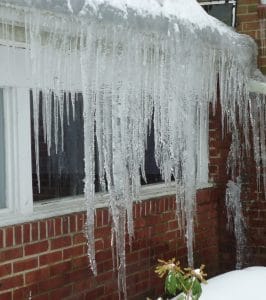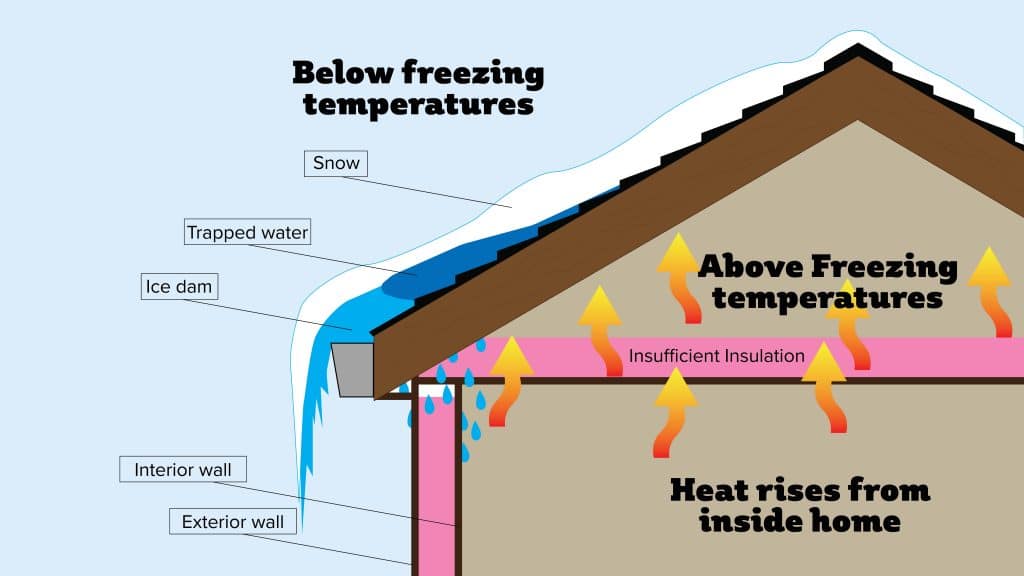With snow piling up on the roof of your property the danger of ice dams is on the rise. While icicles can be very pretty, they are often a red flag indicating an ice dam is or has already formed. Ice dams are created when snow is on the roof and the heat from the building escapes from the interior of the home into the attic and heats up the roof. Once the heat has reached the roofline, it begins to melt the snow sitting on the roof. When the snow turns into water, it will then travel down the pitch of the roof. At the eaves of the house, there is no insulation therefore it will begin to freeze again. Thus causing the dreaded ice dam!
If you would like a condensed bulleted version click here (ICE DAM PDF) for a downloadable PDF

Once the ice dam has formed on the eaves or valleys, water has an increased opportunity to seep into your home from the water pooling up on the roof. The water typically will find any small hole in the roof and then migrate down through the attic, eventually reaching your insulation, interior walls, and drywall inside of the home. If left unattended this water damage can eventually create structure damage as well as promote the growth of mold which is not good for your home, your health. If you notice mold growing inside your home, call a mold remediation specialist ASAP. Sometimes the ice dam can get very heavy and it can cause trouble to your gutters and spouts outside as well. It should also be noted there is a danger of these falling when the weather warms up which can cause harm to people walking around the building or to the building itself.

The best way to avoid any of these issues is to prevent them from forming. So what can be done to prevent or fix an ice dam?
Temporary fixes
Heated cables
Many people will utilize heated cables to not allow ice to form on the eaves. This can be effective as well as expensive. Typically every 100 feet of cable will increase your power bill by $40-60 per month. 100 feet of cable will cover approximately 35 lineal feet if you have 18-inch overhangs on the eaves. If you have gutters 100 feet of cable will only cover 25 lineal feet. If you only have a few problematic spots on your building, this could be a solution. If you have more than just a couple of trouble spots, this might not be the solution you are looking for, since it will be costly to power the cables.
Fan
Placing a fan in the attic pointed at the location where the water is coming in can possibly cool off the area to freeze the water. This will stop the water from entering the home, but it is merely a band-aid at best. However, if you don’t have the time to get to it, you could try this technique to buy yourself some time, or call a professional restoration company to come out and fix the issue.
Pantyhose
If you have an ice dam that has already formed, one technique is to use some pantyhose filled with calcium chloride ice melt. Place the ice melt filled pantyhose on top of the ice dam, with it extended over the gutter and off of the roof. The ice melt will melt through the snow and ice and eventually down to your roof, thus creating a channel for the water to move through and off of your roof instead of inside your building.
Roof rake
After a snow event, removing any accumulated snow will keep your roof free of the possibility of an ice dam forming. There are other tools and techniques used for roof snow removal, which is covered in the previous blog post Roof Snow Maintenance and Tools.
Permanent Fixes
Install a cold roof
Creating the same temperature throughout your roof is the only way to permanently avoid a possibility for ice dams to form. Cold roofs are essentially a roof on top of a roof. They have proper venting in the soffits and the ridges of the building. This venting ensures the temperature is consistent throughout the entire roof, which eliminates the growth of ice at the soffits and valleys.
Ventilate
If there is room in your soffits and ridges to add venting, this is also a solid method of avoiding ice dams indefinitely. Homes should have one square foot of opening per 300 square feet of attic floor. This venting will not only keep the roof temperature consistent but will also keep your home cooler in the summer.
Add insulation
If you have proper venting in place but are still noticing ice dam formation, then you are likely lacking proper insulation in your attic. Add more insulation to increase your R-factor and retain that precious heat. Once the proper insulation has been added, Ice dams should be extinct.
Other tips and considerations
Exhaust to outside
If you have bathroom or kitchen vents exhausting to the attic, re-route them to exhaust to the exterior of the building, either through a wall or through the roof.
Install sealed can lights
Some older can lights in the ceilings cannot be covered by insulation due to fire hazard. Update your old cans with newer “IC” fixtures that can be insulated over, which will reduce your heat build-up as well as less heat to your roof.
Caulk penetrations
Caulk around any penetrations with fireproof caulking or foam that go through the ceiling, like electrical cables and vent pipes. Less heat escaping the interior of the building means less heat loss and less heat to the roof.
If your home or business has an Ice Dam and you don’t want to tackle it yourself or are unable to, Disaster Response is here for you. We have years of experience dealing with snow and ice damages, with the technicians to get you ice dam free.


